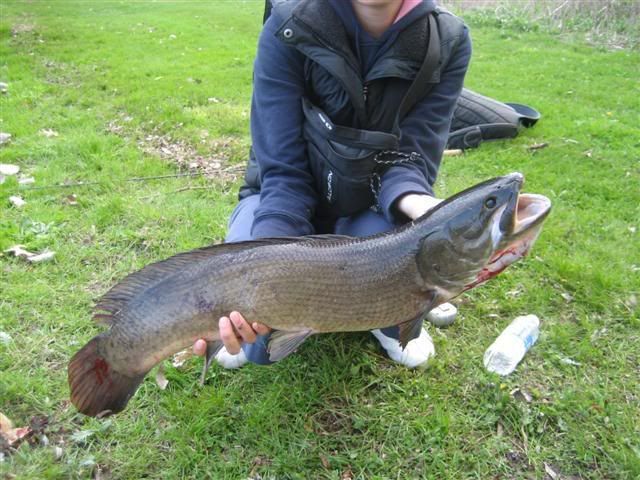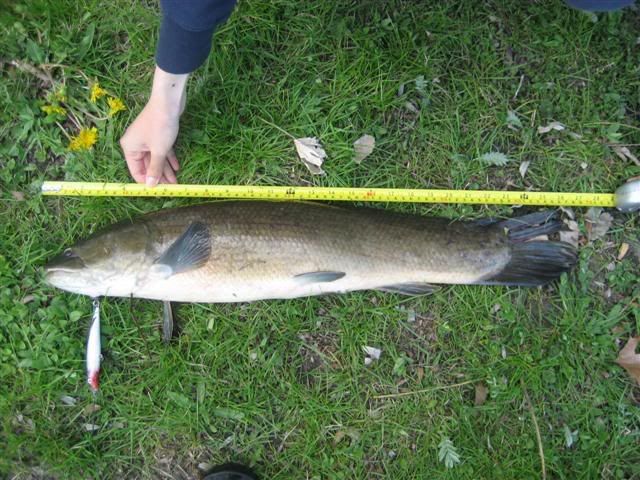tangledline
Well-Known Member
- Joined
- Jul 10, 2008
- Messages
- 566
In May 2008 i believe a fish that i repeatedly saw in the Trout Pond at Toronto Islands was a Bowfin.....
i am 85 % sure ...so my project this year is to catch..photograph..release one - so that i can stop dreaming about the darn fish and move on...but from researching the fish its sounds like they are a good fighting fish...saw some utube video to back that fish's reputation too...also historically speaking they are pretty darn interesting...read below.... if you have any info about bowfin being caught in lake ontario let me know i would certainly appreciate it.
thanks....
http://www.dec.ny.gov/images/fish_marin ... owfinn.gif
http://flickr.com/photos/28113115@N00/1098346625
Bow Fin - (Amia calva)
Length: 18 to 24 inches
Weight: 2-3 pounds
Coloring: back and sides olive-colored, often with dark mottling; belly cream-colored to white; paired fins and anal fin are bright green
Common Names: dogfish, mudfish, grindle, lawyer
Found in Lakes: Lake Michigan (Green Bay), Lake Huron, Lake Erie, Lake Ontario
The bowfin is the only living member of an ancient family, which is the only family remaining of the order Amiiformes. Bowfins are especially well-represented in fossils from the middle Mesozoic era, more than 100 million years ago.
The current species is somewhat of a relict, with a primitive skeleton (part bone and part cartilage) and a double skull (a bony outer layer and a cartilage inner layer), characteristics it shares with members of the gar family. Fishes of more recent ancestry have skeletons made entirely of bone.
Yet the bowfin is an evolutionary step beyond the gars, even though it is an evolutionary step behind more modern fish. While gars have thick, diamond-shaped scales that do not overlap, bowfins have thin scales more like those of modern fishes. They are also the only primitive fish to provide parental care for their young.
Bowfins live in lakes and large slow-moving rivers with plentiful vegetation. They tolerate silt and mud and can survive in warm, stagnant water by breathing air. Most fish use their gas bladders for buoyancy, but the bowfin's gas bladder also allows it to extract oxygen from the air. This ability to breathe air may allow bowfins to burrow in mud to survive drought. A similar behavior is seen in African lungfishes and is called aestivation. Tomelleri and Eberle in Fishes of the Central United States cite farmers in the Mississippi Valley "who occasionally turned up live bowfins with the plow after floodwaters had receded from farmland."
Bowfins reach spawning age within 3-5 years. Males are always smaller than females and probably do not live as long. They spawn in the spring in nests the male has created by biting off the vegetation in an area of 1.5 to 2.5 feet in diameter. Males protect the eggs, and later, the young fish, for the next few months. They are very vigorous in their defense of the nest--biting intruders (including humans) and even propelling themselves out of the water. This flurry of activity stirs up the water enough to hide the young fish, which scatter for cover.
Young bowfin eat phytoplankton, zooplankton, and insects. The adults, however, are voracious consumers of fish, although they will also eat crayfish, small rodents, snakes, turtles, and leeches.
Because of its tendency to eat other fish, including desirable game fish, the bowfin is not generally appreciated by anglers. Yet it is an important part of the ecosystem--it inhabits waters generally populated by panfish or nongame fishes, and its performs the population control necessary to prevent stunting. (See the pumpkinseed description for more information about stunting.) In Fishes of Wisconsin, George Becker states, "The bowfin is frequently part of the fish fauna in many excellent sport and panfish waters in Wisconsin. In fact, the quality of such waters may be attributable in part to the presence of this species."
i am 85 % sure ...so my project this year is to catch..photograph..release one - so that i can stop dreaming about the darn fish and move on...but from researching the fish its sounds like they are a good fighting fish...saw some utube video to back that fish's reputation too...also historically speaking they are pretty darn interesting...read below.... if you have any info about bowfin being caught in lake ontario let me know i would certainly appreciate it.
thanks....
http://www.dec.ny.gov/images/fish_marin ... owfinn.gif
http://flickr.com/photos/28113115@N00/1098346625
Bow Fin - (Amia calva)
Length: 18 to 24 inches
Weight: 2-3 pounds
Coloring: back and sides olive-colored, often with dark mottling; belly cream-colored to white; paired fins and anal fin are bright green
Common Names: dogfish, mudfish, grindle, lawyer
Found in Lakes: Lake Michigan (Green Bay), Lake Huron, Lake Erie, Lake Ontario
The bowfin is the only living member of an ancient family, which is the only family remaining of the order Amiiformes. Bowfins are especially well-represented in fossils from the middle Mesozoic era, more than 100 million years ago.
The current species is somewhat of a relict, with a primitive skeleton (part bone and part cartilage) and a double skull (a bony outer layer and a cartilage inner layer), characteristics it shares with members of the gar family. Fishes of more recent ancestry have skeletons made entirely of bone.
Yet the bowfin is an evolutionary step beyond the gars, even though it is an evolutionary step behind more modern fish. While gars have thick, diamond-shaped scales that do not overlap, bowfins have thin scales more like those of modern fishes. They are also the only primitive fish to provide parental care for their young.
Bowfins live in lakes and large slow-moving rivers with plentiful vegetation. They tolerate silt and mud and can survive in warm, stagnant water by breathing air. Most fish use their gas bladders for buoyancy, but the bowfin's gas bladder also allows it to extract oxygen from the air. This ability to breathe air may allow bowfins to burrow in mud to survive drought. A similar behavior is seen in African lungfishes and is called aestivation. Tomelleri and Eberle in Fishes of the Central United States cite farmers in the Mississippi Valley "who occasionally turned up live bowfins with the plow after floodwaters had receded from farmland."
Bowfins reach spawning age within 3-5 years. Males are always smaller than females and probably do not live as long. They spawn in the spring in nests the male has created by biting off the vegetation in an area of 1.5 to 2.5 feet in diameter. Males protect the eggs, and later, the young fish, for the next few months. They are very vigorous in their defense of the nest--biting intruders (including humans) and even propelling themselves out of the water. This flurry of activity stirs up the water enough to hide the young fish, which scatter for cover.
Young bowfin eat phytoplankton, zooplankton, and insects. The adults, however, are voracious consumers of fish, although they will also eat crayfish, small rodents, snakes, turtles, and leeches.
Because of its tendency to eat other fish, including desirable game fish, the bowfin is not generally appreciated by anglers. Yet it is an important part of the ecosystem--it inhabits waters generally populated by panfish or nongame fishes, and its performs the population control necessary to prevent stunting. (See the pumpkinseed description for more information about stunting.) In Fishes of Wisconsin, George Becker states, "The bowfin is frequently part of the fish fauna in many excellent sport and panfish waters in Wisconsin. In fact, the quality of such waters may be attributable in part to the presence of this species."




